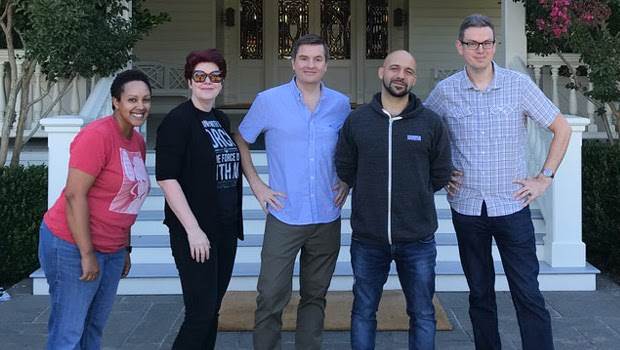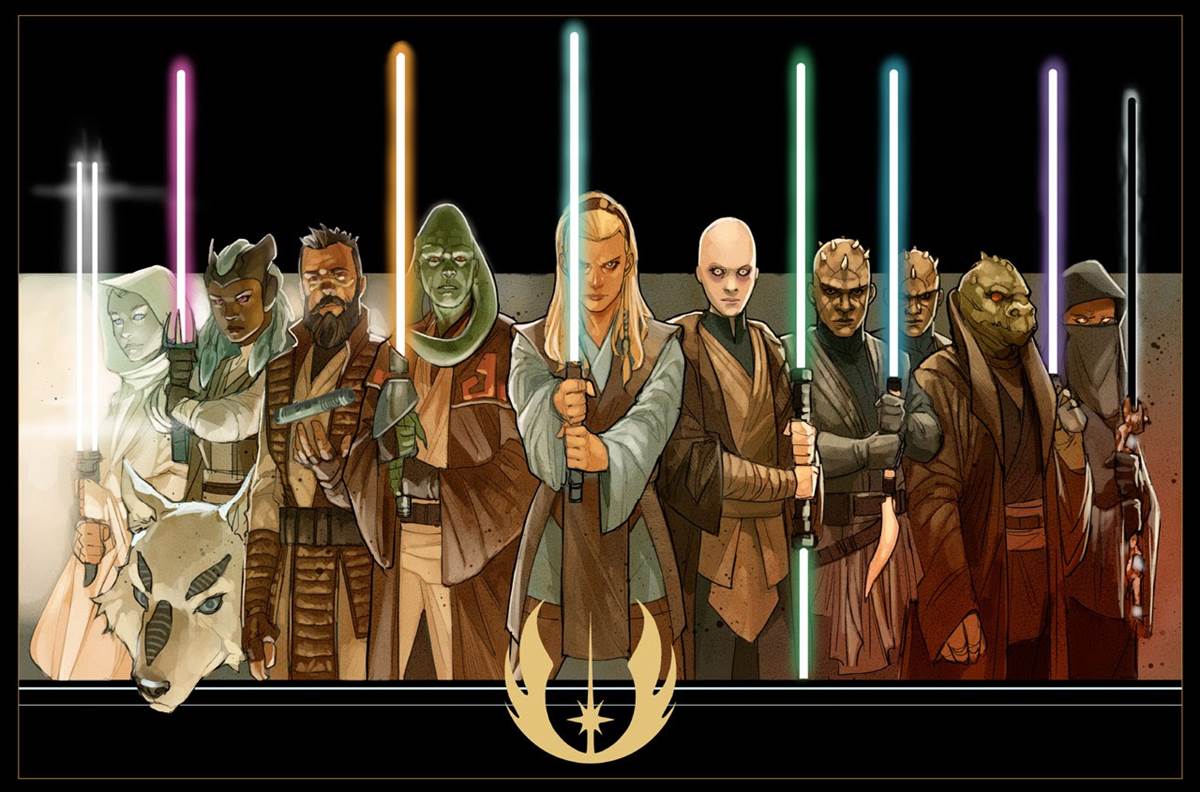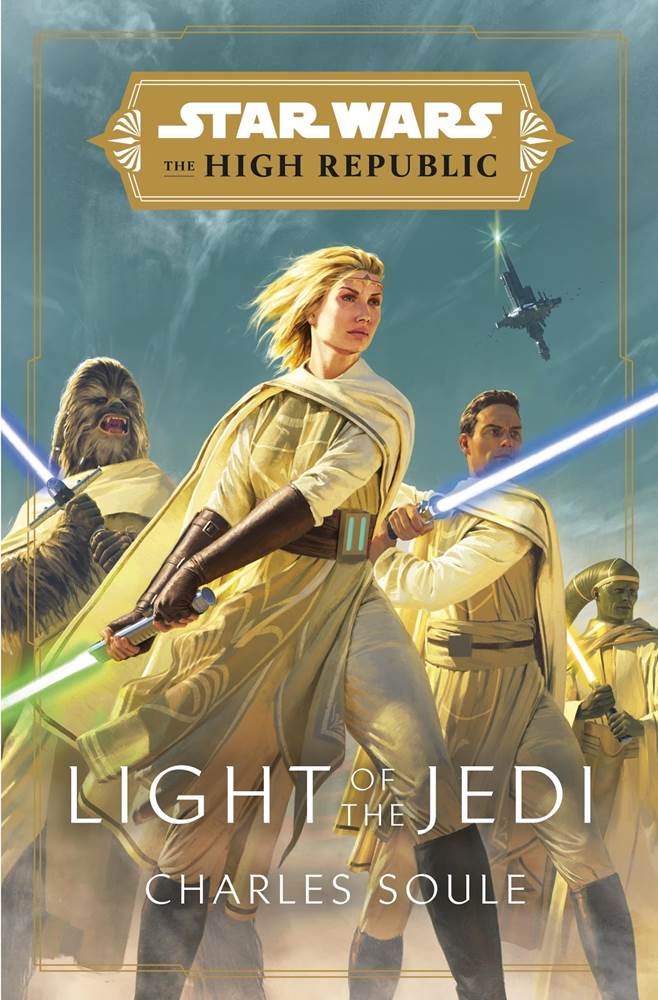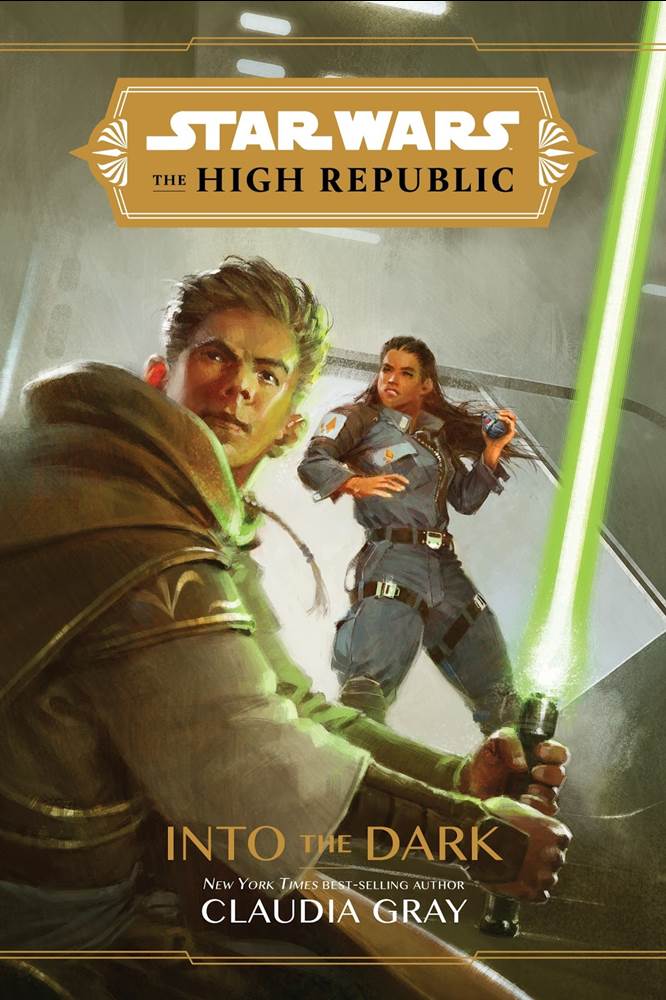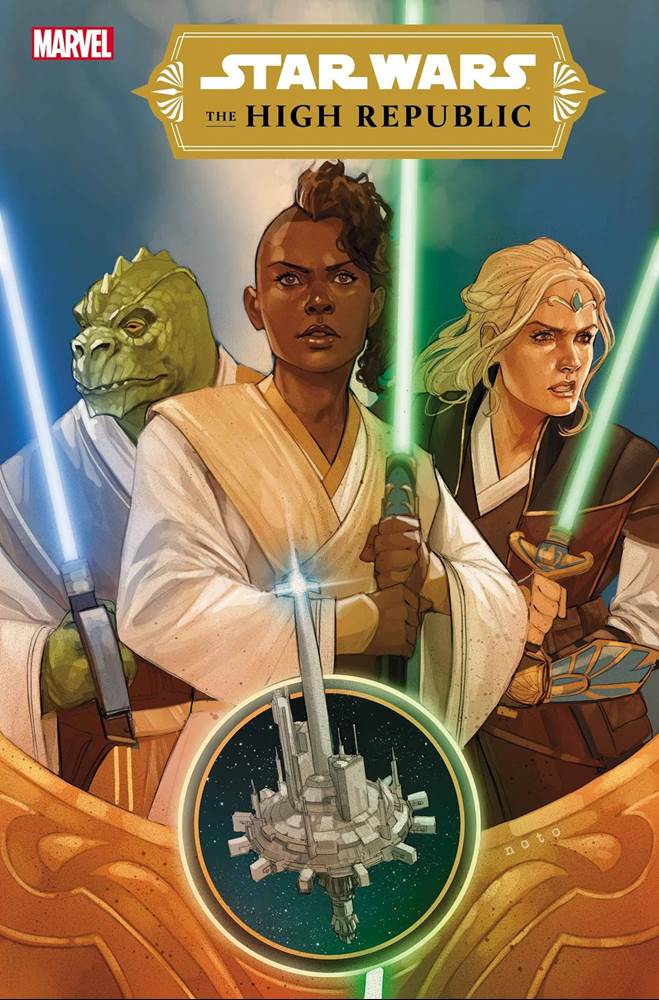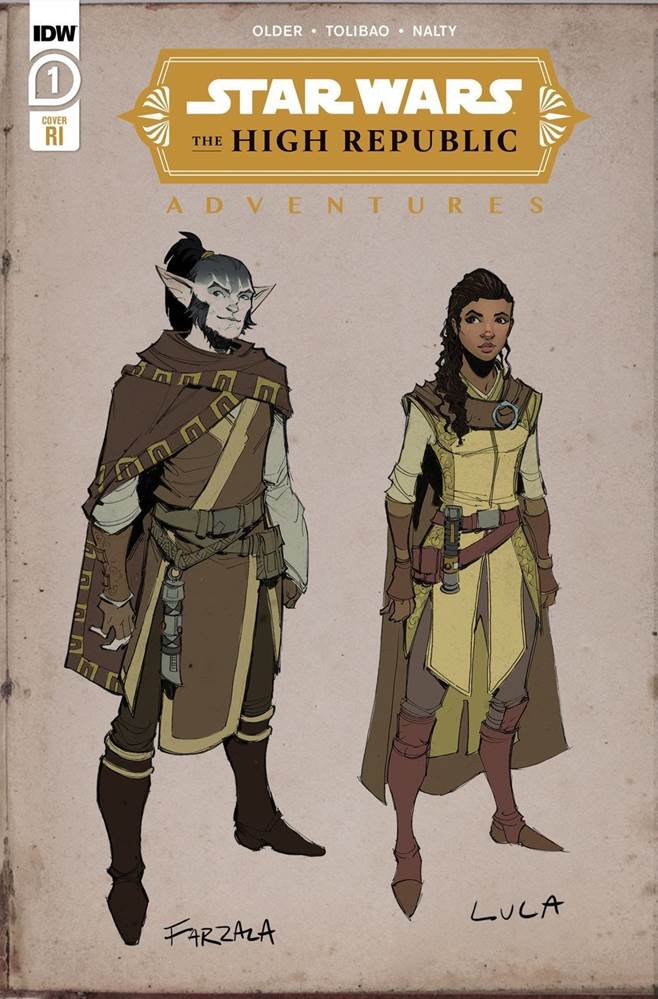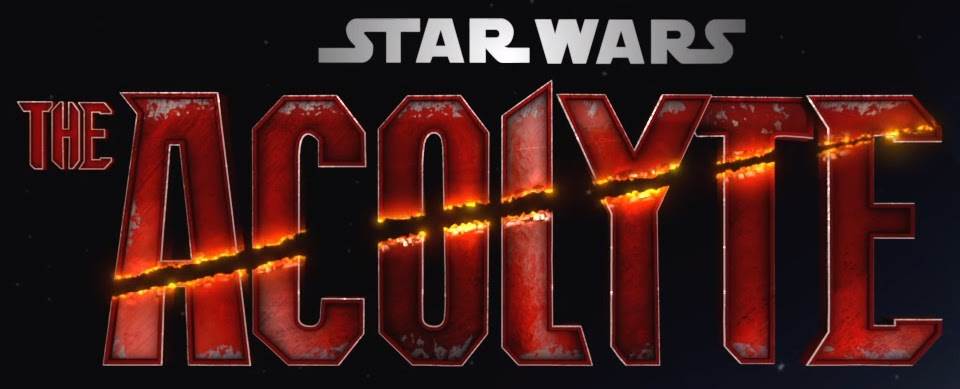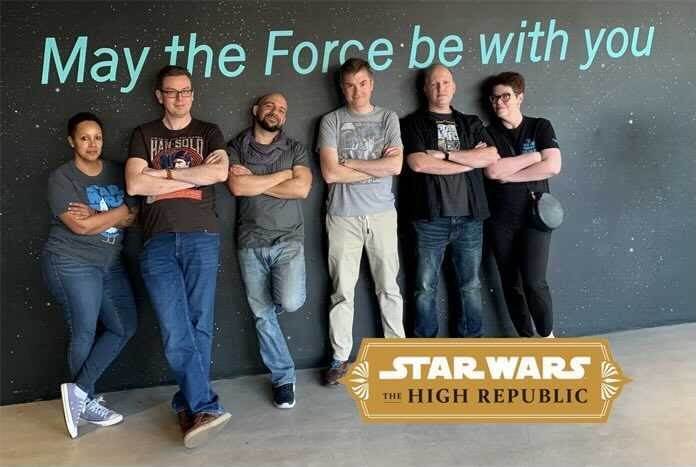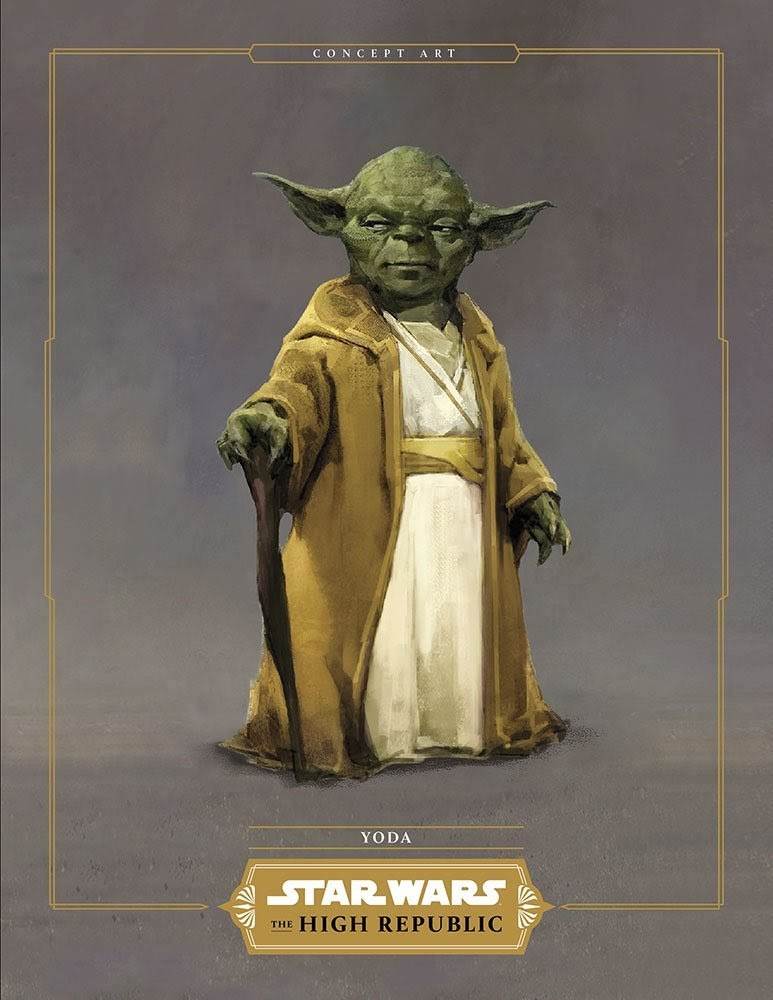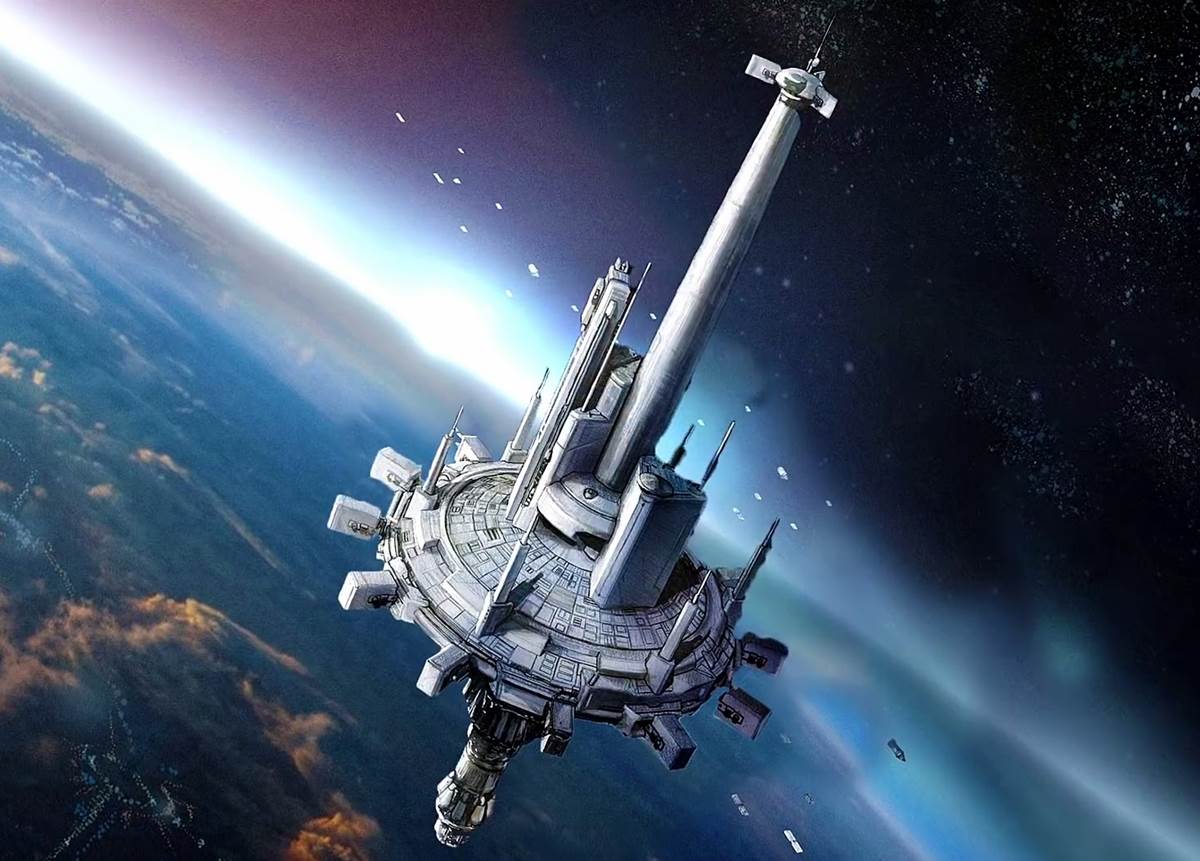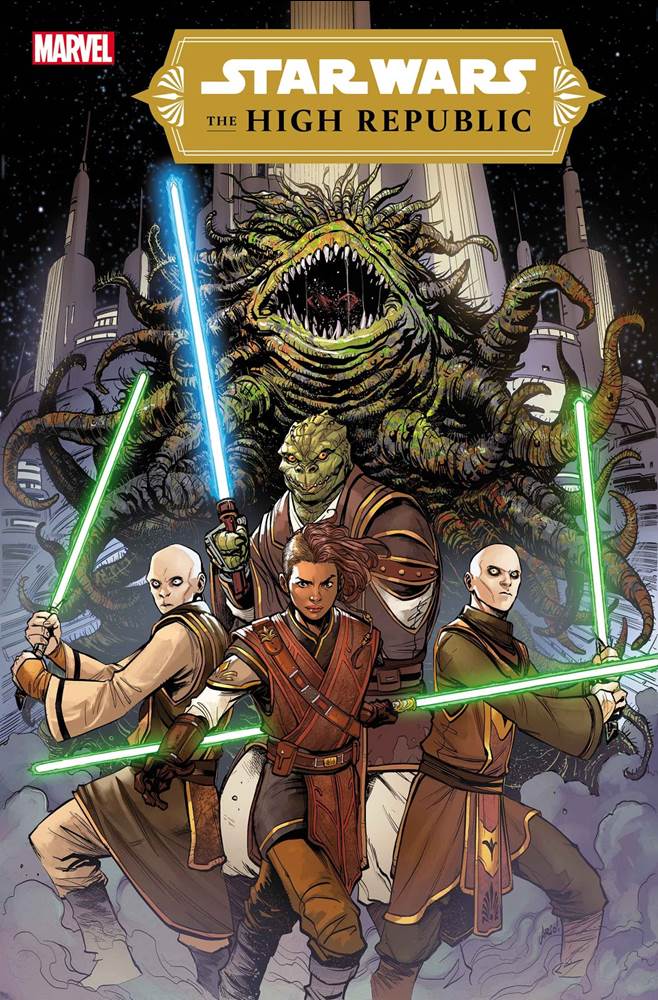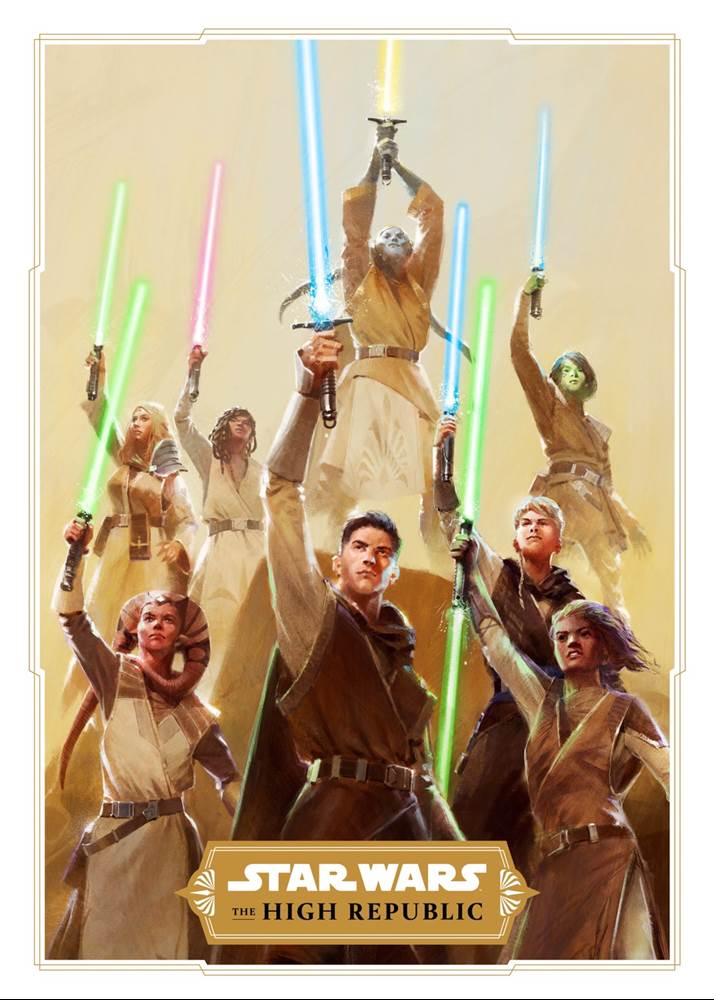Star Wars: The High Republic is an ambitious new multi-platform storytelling initiative being launched by Lucasfilm Publishing at the beginning of January with multiple Star Wars novels and comic books set hundreds of years prior to the events of the more familiar Skywalker Saga. So far I’ve had the chance to read the first three books in the series and you can read my reviews of each elsewhere on this website.
This week I was also given the opportunity to interview all five authors writing published content for Star Wars: The High Republic— Charles Soule (Light of the Jedi), Justina Ireland (A Test of Courage), Claudia Gray (Into the Dark), Cavan Scott (Marvel’s The High Republic comic book), and Daniel José Older (IDW’s Star Wars: The High Republic Adventures comic), along with Lucasfilm Publishing’s creative director Michael Siglain. The in-depth conversation took place between the six of us all at once for thirty minutes over zoom, and is included in audio form as part of Episode 43 of my Star Wars podcast Who’s the Bossk?, but you can also read along in transcribed form below. Enjoy!
Mike Celestino, Laughing Place: My first question is for Michael Siglain. Besides the obvious timeframe difference, what sets The High Republic apart from the Star Wars that we’ve seen before? What kind of stories can you tell in this era that we couldn’t get, say, in the period before the Clone Wars as depicted in The Phantom Menace?
Michael Siglain: I think what sets this apart is the newness of it all from a storytelling perspective, and also the fact that we are in a Galactic Renaissance when this story opens. The galaxy is at peace. That’s not something we’ve seen in Star Wars. It’s always been Star Wars. And we have the ability here to get a snapshot of the galaxy at a time when the Jedi are at their height, the Republic is at its height, and it’s glorious. And into that comes this threat that begins to grow and grow and grow, and we get to see how the Jedi who are at their height now have to react to something like that. How does a beautiful Republic react to something that no one is expecting? Not too dissimilar, honestly, from what we’ve been dealing with in the world right now. How do we react, globally, to a pandemic? How does the galaxy react to a Great Disaster and everything that comes from that?
LP: For Charles Soule, what was it like making the transition from your work in Star Wars comics to Star Wars novels, and how did you personally approach the difficult task of writing Light of the Jedi, the kick-off novel for The High Republic— having to introduce all these new characters and this previously unexplored era of the Star Wars universe?
Charles Soule: Shifting from comics to novels… I have written a couple of other [non-Star Wars] novels before Light of the Jedi, and so I know how to build a novel. I know the work involved in it, the way it goes through the many existential crises you have along the way when you’re creating a novel, and the path of it. So I kind of knew what I was getting into in terms of a process. As far as shifting from Star Wars comics to Star Wars novels, I love working in comics. I know a lot of us have done work in comics, and part of it is because it’s collaborative. But I also love writing novels, because you get to take the audience’s point of view and their attention and shift it wherever you want. You can go really deep into things in a way that can be more challenging to do in comics, and so I loved being able to take these concepts that we all build with The High Republic and really explore them.
I think a good example of that is the way the character Jedi Master Avar Kriss used the Force– the way that she experienced the Force as a song, as a giant symphonic piece of music. I’m a musician myself, so being able to write about the Force in a way that was personally meaningful was just awesome. I loved being able to shift from Star Wars comics to Star Wars novels. I still do a bunch of Star Wars comics and intend to keep doing them for some time to come, but the novel experience was great.
As far as this particular novel, Light of the Jedi being pretty important in terms of the overall launch of The High Republic— something that we’ve all been working on collectively for two and a half years– having a lot of the weight be on this novel was a challenge. It was intimidating, for sure, because I really did not want to screw it up. I wanted to make sure that I was giving value to the work that all of us had done, but fortunately I didn’t really have to do it by myself. I typed the words, but I had a crew [of authors crafting the project], plus [the Lucasfilm] Story Group, plus a bunch of other people who were really able to give me tons and tons of support. Star Wars has never really been made in a vacuum– I guess space is a vacuum, but you know what I mean. George Lucas didn’t make Star Wars by himself, and the same is true of Light of the Jedi. The same is true of everything we’ve all done here. We all did this together, and I don’t think any part of it would be as good if we hadn’t.
LP: For Justina Ireland, your novel A Test of Courage is the middle-grade entry in this first phase of The High Republic. What is it about the Jedi that you think appeals to younger readers and what themes did you want to include in this story to help convey what the Jedi Order is all about?
Justina Ireland: I mean, they’re space wizards. [laughs] I don’t know that there’s anything that doesn’t sound cool about that. So, every morning I start my day by watching The Today Show, which is god-awful, but it’s a nice rhythmic start to my day. I watch my local offering and at 7:00 The Today Show comes on, and they always have this thing called ‘The Morning Boost.’ And today’s ‘Morning Boost’ was the little black kid in front of the electric fireplace pretending he has super powers. He’s turning it on and his mom has the remote and he’s like, ‘I have powers!’ And his mom turns it off and he’s like, ‘Abracadabra!’ If you haven’t watched the video you can go find it. But the thing is that kids love the idea of being something extra– of being super. I think we all do, but when you’re a kid, it still seems possible, right?
If anybody’s like, ‘Justina, you’re 42. You could be president one day,’ I would laugh, because I would be like, ‘the previous 42 years of my life say no.’ I have baggage. Whereas when you’re eight, you have no baggage. Your baggage is you didn’t get to have pizza for lunch. So you get to come into the storytelling in such a fresh, open perspective that we don’t necessarily get with older fans, which is one of the reasons I always urge older fans, ‘go read the offerings for younger readers,’ because they’re so much fun. They’re so Star Wars without maybe some of the baggage we get once you’ve been a Star Wars fan for 40 years. One of the reasons I think the Jedi do appeal is because they have that chance to be something more than just the regular person. But what’s also cool, not just about the Jedi but about Star Wars in totality, is it’s always been a storytelling that’s welcomed child perspectives and hasn’t treated them as lesser-than.
I think that’s really something that as adults we don’t necessarily recognize with storytelling. As a parent in the modern age and going back and watching the things that I liked as a kid, the tonal shift in that storytelling, where we include parents in the storytelling now as opposed to making movies down to younger viewers– we have those jokes where the parents are going to get it and maybe not the kids in the room– that’s a newer thing for a lot of media, but not for Star Wars. You could go back and watch Star Wars things you watched as a kid– even the LEGO offering, which I know are not canon, but are still a lot of fun– there’s still something there. That’s the excitement about writing a kids’ book: I can write about big, heavy themes– grief and death and loss and how we deal with those things, but I can also write about little monkey-like creatures that are rainbow-colored and live in the trees. And I can do it in the same book, and nobody’s going to care. That’s the best thing about writing younger-reader stories: you have that latitude to make Star Wars just as fun as you want it to be, and just as serious as it usually is as well.
LP: For Claudia Gray, your young-adult novel Into the Dark includes both the Nihil, who are the overarching antagonists of The High Republic, and introduces another faction of enemies that I don’t want to spoil in any detail except to ask you to talk about the threats facing the Jedi during this period. How are the various villains different from the Empire or the Sith or the First Order?
Claudia Gray: I think it is so important that the Jedi begin this initiative really without a defined enemy, and haven’t had a substantial one in a while. I mean, that’s what being a good guardian of peace and justice leads to. It’s interesting, because right when we began working on this, I saw a talk that Grant Morrison gave about writing Superman. He actually said one thing that really was pertinent: ‘I realized part of the trick of it was Superman’s body language would be very casual. He’d be very relaxed because nothing can hurt him. He is 100% confident. He’s 100% invulnerable. This is not a tense person. He’s okay, you know?’ [laughs] And not to that extent with the Jedi, but that is sort of where we catch them at the beginning of this. The worlds operate in a way that they understand, and the last generation of Jedi understood, and now we’re throwing this into the mix.
They’re not going up against Empires or aspirings Empires [that we’ve] seen before. They’re going up against very different enemies here. I can’t believe I want to talk about the American Revolution, but part of the thing there was the really really big army can beat a really big army, but when all of a sudden you have small bands who are located over here and over here and over here, and they don’t want to take over everything– they’re just going to hit this today– that’s actually sometimes much harder to defend against, as history shows. I think that, at least where we begin with the story, that’s where these enemies are coming from. You have to look everywhere. There isn’t a border; there’s not a treaty; there’s not anything like that. You don’t know where they are and you’re still figuring out exactly what they want.
LP: For Cavan Scott, how does Marvel’s Star Wars: The High Republic comic book fill in the gaps between what we’re reading in the novels and how does working in a more visual medium help get across what your group is going for in this initiative?
Cavan Scott: Well there’s the obvious answer to that, [which is] we get to literally show how glorious and new all this technology is, because in Star Wars we’re very used to seeing a very grungy, lived-in universe, with ships that have been around and have been through the mill a lot, and gone through many different owners who haven’t exactly been careful with them. With this, all the stuff we’re seeing in The High Republic is when it’s literally at its shiniest. It’s when it’s straight out of the packet, its factory-default settings, and it’s got that sense of when you get anything new and it’s got that smell of new and fresh and excitement. That’s what the entire universe feels like at the minute in Star Wars. For the majority of people, it’s a time where anything is possible and everything is fresh, and every day brings a new advancement in technology or a new planet that’s joining the Republic, or a new frontier that’s being crossed literally and figuratively.
Through the amazing art that both Daniel and I can show through our comics– and not because of our particular talent, but because of the talent of our artists– we’re literally getting to show that, and that’s the most exciting thing, I think, for us: when we see the first pencil [drawings]. When we were starting to explain what the ships were like, and the [Jedi starship] Vectors and that, to actually then see a Vector bursting out of a page was incredible. That’s really important. How does the comic fit into the larger story? Well, it tells the story of Jedi in the middle of it all, and it tells the story of how people relate to the Jedi, from the point of view of a Jedi. So we get to see what it’s like to be a Jedi, to go into a planet, and for everyone to look to you for protection, for inspiration. You walk out of your ship, and you walk down that ramp, and they’re all very confident– they’ve been here, they are the peacekeepers who actually have done their job very well and they have maintained peace.
And then suddenly to have one of the people you’re going there to protect or to live alongside turn around and say, ‘No no, we don’t need you, thanks. We’re fine.’ How do you cope with that? And to take it one step further, to face a brick wall when you come off that ship, of someone saying, ‘We definitely don’t want you on this planet. Get off. This has nothing to do with you.’ And so all of these Jedi have these decisions they have to make of how they’re going to react to that and what kind of Jedi they’re going to be. Which I think is a fascinating way, because again, it’s Jedi [as] we’ve never seen them in this world before. This is the Jedi where they are completely equal to the Republic. They are not subservient to the Republic, but they are partners to the Republic. And they are equal to the people that they’re going to protect, as well, and they are very aware of that. That’s been really interesting to play with.
LP: For Daniel José Older, your comic for IDW, Star Wars: The High Republic Adventures is intended for a broader audience, including younger readers. How do you go about appealing to those younger readers? How do you get kids into comics, and more specifically Star Wars comics and the concept of The High Republic?
Daniel José Older: One thing I think that’s so great– and Justina touched on this perfectly– about Star Wars is that it has always been all-ages. Yes, it can get very dark and intense and go full Rogue One, and also it can go in full other directions. It’s all there, and that’s a part of it all. I think with this, for me and for all of us that were writing for young people, it was very specifically about putting those young people front and center in the story, and really making it about them and their decisions and their challenges and how they step up to this changing galaxy and how they deal with their changing understanding of the world and themselves and their powers as things are reaching crisis point.
Yoda plays a major role; Yoda is the coolest chaperone you would ever want on an intergalactic journey with all your friends, which is basically what’s happening in The High Republic Adventures. But the story is really about Zeen, whose best friend Krix very quickly ends up hanging out with the Nihil. We learn about the upper echelons of the Nihil leadership from a very inside perspective, and we learn about what it’s like for someone who’s Force-sensitive to be suddenly around all these other Force-sensitive people and the Jedi, and what that means. We have all these cool moments of being the new person, and also being the person that has all your friends around and gets to travel the galaxy with all your friends. That’s really what it’s about; it’s a lot of fun.
LP: We got the announcement last week of a television series set during “the final days of The High Republic era,” called Star Wars: The Acolyte. Obviously I know you can’t give me any more details on that, but I wanted to ask you all how it feels that Lucasfilm is putting that kind of multimedia energy into something you helped to create.
Older: It’s mostly just really exciting. That’s what Star Wars has always been: getting to see the world from all these different perspectives– the virtual reality piece, Yoda in the High Republic on Batuu is super cool, this is super cool. It’s just amazing. We came into this knowing that we would get to see this part of the world in different forms, and it’s amazing to see it happen again.
Soule: To add to that, I would say that that program is set a fair amount of time after the story that we’re telling here, and that’s a wonderful thing because it means that the era [of] the High Republic, which we all built and created, is rich enough to sustain storytelling at a lot of different points in the timeline. Which for me is really exciting, because we built this thing, and now it’s taking on a life of its own. What more could you ever want than that? It’s wonderful.
LP: I want to get a little bit more into the collaborative nature of the group, as you guys have talked about a bit already. Obviously you went off to write your own entries as individuals, but you were initially assembled to create this whole timeline. Can you tell me more about the process that went into coming together to generate The High Republic as a concept?
Scott: I think one of the important things is it’s interesting, because you say we went away to write our own things, and I don’t feel we’ve ever been apart. We’ve been apart physically, for very obvious reasons, but even when we’ve been working on the individual elements which make up The High Republic, we’ve been in touch literally every day; there is some form of contact. This has been a joint effort, and the exciting thing is that because we haven’t been creating things in silos, something that’s happening in another part of the initiative affects what you’re writing in your book. And it doesn’t always go to plan, because sometimes you’re planning something and then you get onto a call or you’ll get onto a message group that we use and someone else will say, ‘I just had a character do this,’ and then you realize, ‘Well, hang on a minute. That’s annoying, because that means I can’t do this.’ But…
Soule: Inspiring! [laughs]
Scott: Inspiring, as I was just getting to. [laughs] The best solutions come out of having a problem to get out of. When you’re creating anything, it’s those unexpected things that get thrown into the mix, just like the characters. The characters’ life would be very very boring if everything was preordained. But those things come out of left field, and everything that’s been cool in this process I think has come out of the point where we’ve had moments when we’ve gone, ‘Oh, how are we going to solve this?’ and the combination of those different viewpoints and those different storylines have always made it better. I think that’s why I found it so exhilarating and exciting and inspirational, because it is five people coming together– and not just five people: you had Mike, you had the Story Group, you had editors. It has been a melting pot of ideas, which means that it’s so much greater than if any one of us had been doing it on our own.
Older: It’s funny, because I always get irritated with Obi-Wan Kenobi with the line about ‘from a certain point of view,’ because it’s such a dodge. But that is also a great quote, and it really does speak to so much of that is cool about Star Wars: we see so many different things from a certain point of view, and the storytelling in different mediums allows for that. I always think about Claudia’s book Lost Stars and how it shows us many events that we’ve seen over and over again in the movies, from totally different POVs, and makes it so thrilling. That’s really the heart of this– that there are these major events in the galaxy that all these different forms and stories touch on in different ways. Star Wars has also always been so in love with history; the history matters so much.
Those major events, they touch other people’s lives [rather] than just main characters and stories. The fallout is real; the repercussions are real. We get to journey with the events themselves and see how they play out in lots of different people’s lives, lots of different planets, lots of different cultures. That’s really been the thrill of it, and we’re able to do that because we’re all in touch and in contact. We reach out and we say, ‘Oh, what’s happening with this?’ And yeah, it throws wrenches into things, but it creates other opportunities that allows us to go in directions we never expected to go in, which is fun.
Ireland: I would say it’s like when the Doctor Strange movie came out, everyone was like, ‘Do I have to watch this Doctor Strange movie to watch The Avengers?’ No one is Doctor Strange here. We are all important and vital and contributing to the storytelling in a real and meaningful way, so yay for us.
Older: That’s true.
Scott: And he ended up being pretty central to the Avengers, so you know…
Ireland: Yeah, that movie, though… [laughs]
Gray: I didn’t see Doctor Strange and I followed the next one just fine. It was like, ‘Oh, it’s Benedict Cumberbatch with magic. Got it.’ [laughs] But yeah, it’s good, like Cav was saying, running into what looks like a roadblock. What comes out of that is almost invariably going to be better than both the things that were going into it.
The thing I always talk about is, going way back in film time before Star Wars— Jaws was originally going to show a lot of the shark. And then the shark didn’t work. The mechanical thing literally broke, and they’re like, ‘We’re only going to be able to have like three minutes of screen time with this shark. And that movie is so much better than it would have been, because Spielberg had to sit down and think, ‘Alright, how do I not show a shark in a movie about a shark?’ He zeroed in on all the fear, and I always go back to that going, ‘When you hit that insurmountable obstacle in storytelling, whether it’s Star Wars or anything else, that’s usually probably the place where you’re going to get something incredible out of it.’ So I’m glad we’re all able to start some sparks.
Older: It’s so cool to read the Return of the Jedi book that they put out– kind of the tick-tock of how they made it and the production schedule and everything. It’s amazing, and in it it has some of the actual conversations that they had with what eventually became Story Group, but before Story Group was a thing, with George Lucas and a lot of his producers and story folks. And just seeing them bat a story around, that really is baked into the history of Star Wars. It’s always been group and communal, even though all praise to George Lucas because it came from him, but he also listened to people in making Return of the Jedi. You can see how he had a certain idea and people would challenge him, and he would be like, ‘Oh, you know what? You’re right. Let’s do this with Yoda instead of Ben,’ and it’s fascinating. And so being in the room as we’re doing that is especially cool, because you can see in a very real way how that makes storytelling different and fun and challenging in whole new ways.
LP: I want to direct this last question back to Michael. I feel like The High Republic might actually be a good jumping-off point for brand-new fans of Star Wars, because chronologically it takes place before so many of the other stories. So how did you and everyone else at Lucasfilm Publishing engineer this series to appeal to both long-time Star Wars fans and those who might be relatively new to the franchise, or new to reading Star Wars content?
Siglain: That was the trick, right? Because we knew that going in. We knew when we were crafting this initiative that we wanted it to be very complex, that we wanted it to have that crossover appeal from one format to another. But at the same time, every book [and] every comic here should be a perfect jumping-on point because it is a new era. We’ve been publishing Star Wars for over 40 years, and to look at just that, it is very daunting. But that also goes back to where we are in the timeline, as to why we’re doing this now. With the Skywalker Saga coming to a conclusion for now, we have the ability to say, ‘Okay, what can we do in publishing that will be big and bold and unexpected, and work with each of these writers, with all of the editors internally at Lucasfilm, with all of the publishers as well, to say, ‘How do we strike that balance of making this satisfying for our fans who’ve been reading for 40 years, and how do we make this satisfying for someone who’s never read a Star Wars book before?’
There was a lot of back and forth with the authors [and] with the editors about ‘How do we do that? How do we find that balance?’ And that’s part of why we are where we are in the era, as well. To say, ‘Hey, this is a Golden Age of the Jedi. You don’t need to have read anything that came before. It certainly helps if you have, but it’s not mandatory.’ Each of the authors have done a truly amazing job of balancing both the core fan and the casual fan. I think there are some deep cuts in there for people who have been reading for 40 years, but they are balanced in such a way that if you don’t get those references, it’s not going to detract from the story. Ultimately, to answer your question, all of the credit goes to the writers, because they did a hell of a job of being able to strike that balance.
Star Wars: The High Republic launches Tuesday, January 5 with the novels Light of the Jedi and A Test of Courage. The full audio of this interview is featured in this week’s episode of Laughing Place’s Star Wars podcast Who’s the Bossk?

